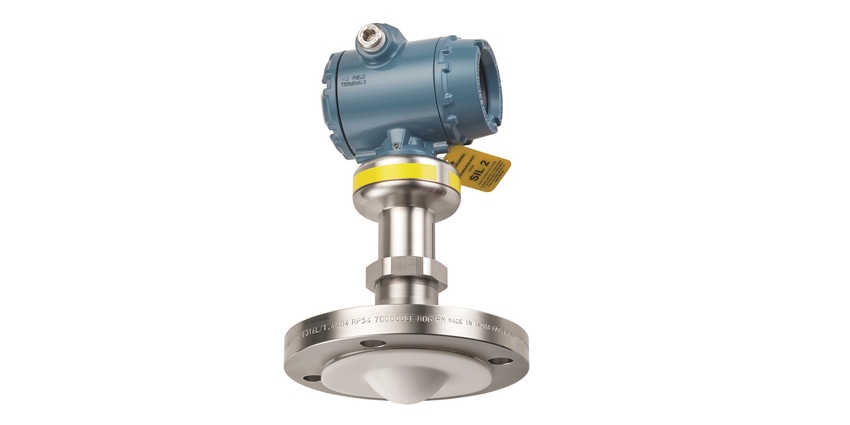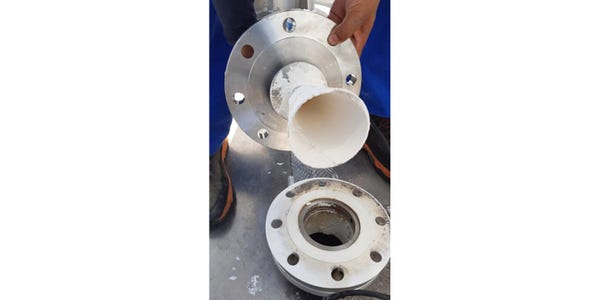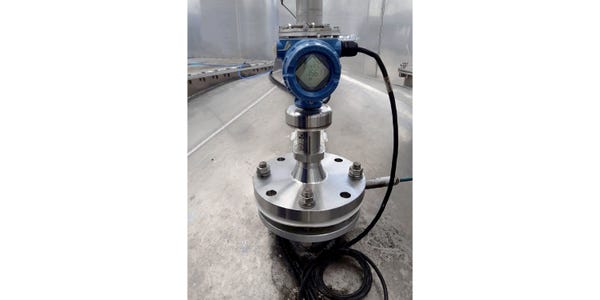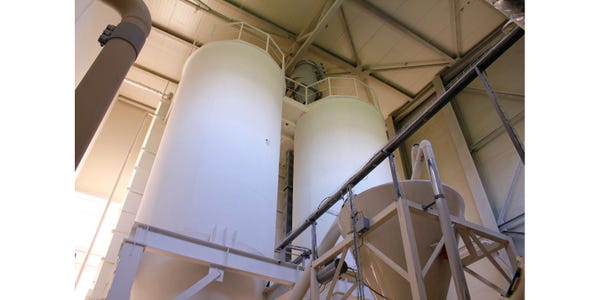Measuring Solid Levels with Advanced Radar Technology
Measuring solid levels with advanced radar technology can improve efficiency, cut costs and increase safety.
October 22, 2020

Ingemar Serneby, senior application specialist, Emerson Center of Excellence for Level
There are a wide range of applications that require the level of bulk solids in process vessels and storage silos to be accurately and reliably measured and controlled. This is essential for several reasons, including helping to ensure consistent product quality, increasing safety by protecting against overfills, and optimizing inventory management and stock availability.
However, measuring the level of solids is not straightforward. Liquid level measurement involves measuring only a single point on the surface – because the level will be identical throughout the vessel. But solids surfaces are uneven, with peaks and troughs that shift constantly as vessels are filled and emptied. Solids applications also often involve process variables such as high levels of dust, condensation, build-up, noise, electrostatic discharges, and materials with low dielectric constants. These factors can affect level measurement accuracy when using certain technologies.
Manual or Automated Measurements
In the past, plants typically measured the level of bulk solids using mechanical devices such as yo-yos, in which a length of wire lowers a weight onto the surface of the material. However, the accuracy of such devices is limited, and they require regular maintenance, which can expose personnel to hazardous conditions on tall vessels. A further problem is that should the weight break free, it could damage machinery.
The availability of digital automation technology has not only improved measurement accuracy, but has also enabled personnel in a central control room to immediately access data from remotely located tanks. This both enhances visibility and increases worker efficiency and safety. Moving away from the use of mechanical devices has also helped to improve measurement reliability and reduce maintenance costs.
Technology Selection
Some solids level measurement applications require only a point-level switch to alert operators to a high-level or low-level condition. Various point-level switch technologies are well proven in bulk solids applications, including vibrating fork switches, vibrating rod switches, capacitance switches, and paddle switches. However, due to the diverse nature of the materials and process conditions involved in bulk solids applications, there is no “one size fits all” solution. The choice of which switch to implement is typically based on the size and space constraints of the vessel or silo, as well as the application conditions.
In addition to point-level technology, most applications will need some type of continuous level reading, typically using a top-down measurement approach. There are various technologies having top-down measurements, including ultrasonics and lasers, but these are often affected by dust. For bulk solids, radar transmitters are a widely applied solution, providing robust and reliable measurements. There are two basic kinds of radar transmitter – guided wave radar (GWR) and non-contacting radar (NCR) – both of which perform level measurements through reflected microwave signals, or echoes. GWR devices send a pulse down a metal probe that extends to the tank bottom, while NCR transmitters send their signal through the open head space with nothing contacting the product.
Guided Wave Radar
GWR transmitters are especially well-suited in applications involving vessels containing powders and small granular materials, and where the installation area is restricted. In bulk solids applications, the material can cause down-pull forces on vessel roofs, so the roof must be able to withstand the maximum probe tensile load, which depends on silo size, material density and the friction coefficient. Forces increase with the buried length, the vessel width and the probe diameter. A flexible single lead probe is the most suitable choice for GWR in bulk solids applications, as long as the tensile load is properly calculated, and the most appropriate cable thickness is used.
GWR works by sending low-energy microwave signals down a probe. When the signal reaches the surface, the microwaves are reflected, and the position of the surface is measured. Some GWR transmitters can use probe end projection functionality to allow for uninterrupted measurements when the surface pulse is too weak for ordinary measurements to detect. This commonly occurs when the material has a very low dielectric constant, especially in combination with a long distance to the surface. When the material dielectric is very low, only a portion of the signal is reflected off the surface and the rest of the signal continues through the material down the probe to the probe end, where there is a strong reflection.
Since the microwave signal propagates more slowly in the material than it does in air, this echo is seen at a distance further than the actual probe end. The actual probe length, the probe end reflection echo location, and the dielectric of the material can be used to calculate the level of the material when the initial reflection from the top of the material is not strong enough to make a direct reading. This function is recommended for solids with a dielectric constant less than or equal to twp, such as perlite or plastic pellets.
Non-Contacting Radar
NCR transmitters use either pulse radar or frequency modulated continuous wave (FMCW) techniques to perform measurements. Pulse radar sends one microwave pulse at a time and waits for the return signal, timing it to determine the distance to the surface where it was reflected. Since microwaves travel at the speed of light, this happens instantaneously. But FMCW devices can improve the measurement of solids compared to pulse transmitters because they continuously send out microwave energy, meaning the total amount of energy delivered to the surface will be much higher. In practice, this means FMCW transmitters are much better than pulse devices at determining weak echoes within a noisy environment.

In bulk solids applications, sloping surfaces deflect energy away from the radar and can generate small reflections. By using a measurement algorithm that merges the peaks of an uneven surface, the latest NCR transmitters can provide high reliability even with rapid changes in level.
NCR devices detect the portion of the surface within their beam angle. Like GWR transmitters, this makes them a suitable choice for bulk solids vessels or silos where quickly shifting material is common. Unlike GWR, however, there are no restrictions with respect to the weight of the material and pull forces.
Case Study: Pasta Manufacturer
An illustrative case study of how advanced NCR technology overcomes difficult level measurement challenges involves a pasta manufacturing company in Brazil. Accurately controlling the level of raw material in each of its flour silos is key to the smooth running of the company’s operation. A lack of raw material can lead to an unexpected profit-draining production shutdown, while an excessive amount of flour in a silo can cause an overspill, the consequences of which can be extremely serious. Most importantly, material or objects falling from silos would present an obvious safety risk and could cause injuries or even deaths. In addition, silos could suffer extensive damage, resulting in reduced storage capacity, while the cost of lost materials, downtime, and clean-up operations could be significant.
The Brazilian company had installed GWR transmitters to provide level measurement in the silos, but they were not working effectively in this application. The devices had flexible twin lead probes and the flour was creating build-up on them, which was continuously causing inaccurate measurements. An additional problem was that the probes were touching the silo walls because of incorrect installation. Because of these issues, the company was unable to use the silos to their full capacity. Production planning was difficult due to the unreliable level measurements of the raw material, which ultimately led to costly losses in production.

The considerable amount of dust in flour silos poses challenges for any measurement technology. NCR transmitters usually handle dust well, but a heavy layer of dust on the antenna can sometimes block the signal. The Rosemount 5408 can overcome this with an integrated air purging system for cleaning the antenna to prevent build-up.

Although the Rosemount 5408 is a reliable device, it provided the company with further peace of mind by incorporating advanced on-board diagnostics that support preventive maintenance, thereby providing a virtually “set it and forget it” solution. The device also provides the advantage of remote proof-testing functionality, which simplifies the procedure of performing the required periodic checks to establish that the transmitter is working correctly. This functionality enables these tests to be initiated quickly and easily from the comfort of the control room rather than having to be performed manually at the silo, thereby saving time and reducing safety risk.
The company was happy with the accuracy of the measurements obtained with the Rosemount 5408. This enabled it to achieve reliable inventory management, resulting in reduced safety stock and on-site loading traffic, as well as increased silo capacity and production. Improved measurement accuracy and reliability has also prevented overfills and avoided accidents. As a result of these positive outcomes, the company ordered 16 units to provide level measurement in all its flour silos.
Conclusion
Although continuously measuring the level of solids can be challenging, today’s advanced radar transmitters can meet the demands of these applications and provide accurate and reliable solutions that increase plant safety and efficiency.
Ingemar Serneby is a senior application specialist at the Emerson Center of Excellence for Level in Sweden. He has been with the company for 30+ years in various positions, including engineering, field level specialist, and product manager, and has experience in advanced radar applications and solutions throughout the world. For more information, visit emerson.com/solidsmeasurement.
You May Also Like


